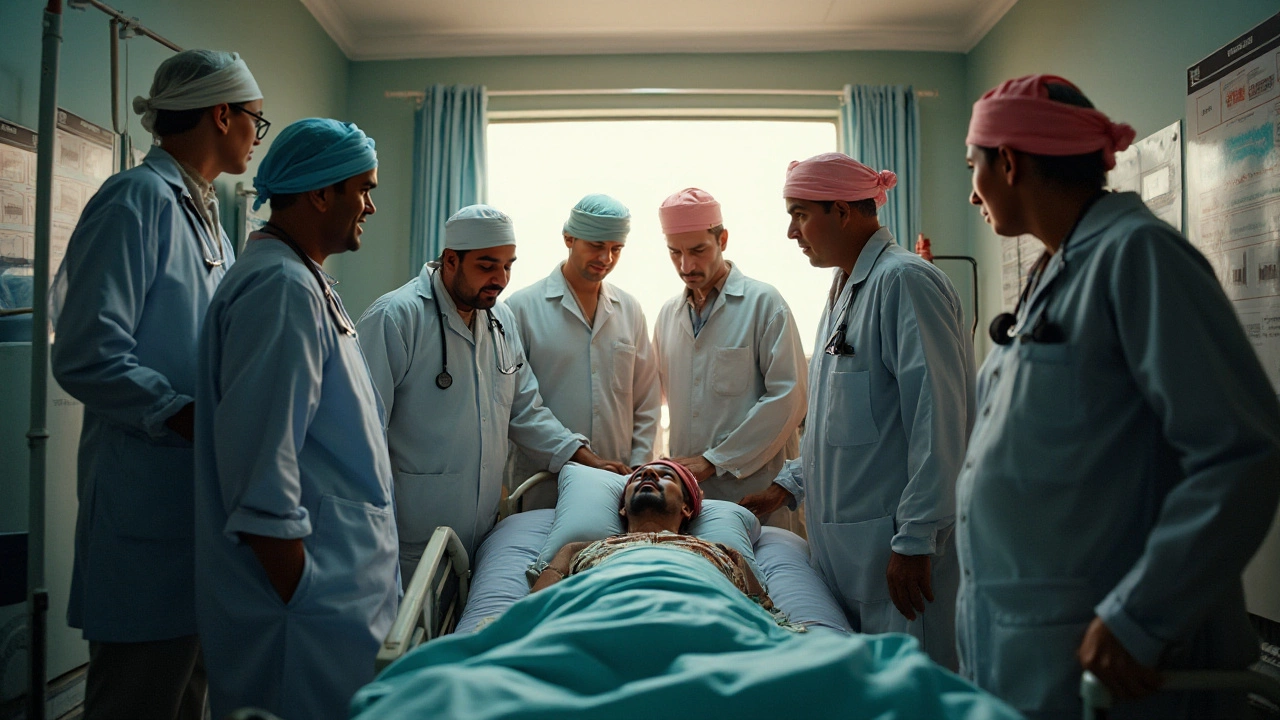
- Jan, 5 2025
- 0
Cancer is a disease that often strikes fear in the hearts of many, and for good reason. It represents a complex set of diseases characterized by the uncontrolled growth and spread of abnormal cells. While there are many types, some cancers pose a more significant threat due to their aggressive nature and poor prognosis.
Let's delve into three of the deadliest cancers known to humanity: lung cancer, colorectal cancer, and liver cancer. These formidable foes claim countless lives each year, despite advancements in medical science. Understanding their nature, risk factors, and the cutting-edge treatments available can help in addressing this pressing global health challenge.
- Introduction to Deadliest Cancers
- Lung Cancer Overview
- Colorectal Cancer Insights
- Understanding Liver Cancer
- Advancements in Treatment Options
- Preventive Measures and Risk Reduction
Introduction to Deadliest Cancers
In the vast landscape of human health, few threats loom as large as cancer. It infiltrates lives, leaving an indelible mark on individuals and families alike. The World Health Organization estimates that nearly 10 million lives are lost to cancer each year. Within this intimidating figure, certain types of cancer stand out due to their lethality. Understanding the dynamics of the most deadliest cancers—lung, colorectal, and liver cancer—is crucial for developing strategies to combat them effectively.
Lung cancer, in particular, possesses a notorious reputation. It often strikes silently, without obvious symptoms until it has progressed to an advanced stage. This insidious nature is one of the reasons why it remains the leading cause of cancer deaths worldwide. Cigarette smoking, exposure to secondhand smoke, and harmful environmental pollutants significantly elevate the risk. A staggering reminder comes from a study noted by the American Cancer Society, which found that smoking is responsible for approximately 85% of lung cancer cases.
"Beyond treatment innovations, primary prevention is key and should focus on reducing tobacco use and mitigating exposure to occupational carcinogens." - American Cancer Society
The story of colorectal cancer is equally daunting. Often dubbed a silent killer, it emerges from benign polyps that can turn cancerous over time. Regular screenings, like colonoscopies, can detect these polyps, yet awareness and access to such preventative measures remain obstacles in various regions. This cancer often strikes those above the age of 50, though recent observations suggest it is increasingly affecting younger populations. A diet rich in red and processed meat, coupled with a sedentary lifestyle, increases risk factors, emphasizing the need for lifestyle modifications.
Liver cancer, although slightly less prevalent, is marked by its swift progression and high mortality rate. Often linked to chronic liver diseases like hepatitis and cirrhosis, it presents unique challenges. Hepatitis B and C infections are major culprits, responsible for chronic inflammation in liver cells. Vaccination and antiviral treatments provide hope, yet the global burden remains immense, particularly in regions with inadequate healthcare infrastructure. The role of aflatoxin exposure, a frequent issue in areas with poor food storage conditions, also significantly contributes to liver cancer risk.
In exploring these deadliest cancers, the importance of continuous research, increased awareness, and advancements in screening and treatment options cannot be overstated. Scientists and healthcare professionals are not fighting a losing battle; rather, they're pushing the limits of what is possible, inching closer to breakthroughs every day. Combating lung, colorectal, and liver cancer requires a multi-faceted approach, one that encompasses prevention, early detection, innovative therapies, and perhaps most importantly, an informed and empowered global community.
Lung Cancer Overview
Lung cancer stands as one of the deadliest cancers globally, claiming more lives than any other cancer. This occurs because symptoms often remain undetected until advanced stages. The primary cause is tobacco smoking, responsible for around 85% of cases, but non-smokers aren't immune; exposure to radon gas, second-hand smoke, and certain toxins also elevate risk. Manifesting in both small cell and non-small cell types, each subtype demands unique treatment approaches. Typically, a persistent cough, chest pain, and weight loss indicate its presence, but these signs often appear once the disease has progressed significantly, complicating early diagnosis.
Lung cancer remains an elusive enemy, affecting millions who often mistake early symptoms for less severe ailments, says Dr. Anna Lee, a renowned oncologist.
Addressing lung cancer requires an intricate understanding of its biology and progression. Treatment usually involves a combination of surgery, chemotherapy, and radiation, each tailored to the individual's needs and the cancer's stage. Today, targeted therapies and immunotherapies offer new hope by attacking cancer cells more precisely and bolstering the immune system's ability to fight. Despite these advancements, survival rates remain low, with only around 20% of patients surviving five years past diagnosis, highlighting the need for continued research and awareness.
The role of early detection cannot be overstated. Initiatives to screen high-risk populations, particularly long-term smokers over the age of 50, utilize tools like low-dose CT scans to spot abnormalities early. Public health campaigns stress the importance of quitting smoking, reducing exposure to known carcinogens, and leading a healthy lifestyle to mitigate risks. The fight against lung cancer also benefits from increased funding for research into more effective drugs and screening technology. Yet, achieving significant breakthroughs requires the global community's concerted efforts to prioritize lung health as a central aspect of public wellness.

Colorectal Cancer Insights
Colorectal cancer, which includes both colon and rectal cancers, represents one of the top threats in the cancer world. This type of cancer begins in the colon or rectum, often starting as tiny, benign clusters known as polyps. These polyps can develop into cancer over time if not detected and removed early. Unfortunately, its stealthy nature means symptoms often go unnoticed until the cancer has progressed. Common signs, such as changes in bowel habits, bleeding, and abdominal discomfort, can easily be mistaken for less serious conditions.
Age plays a significant role in the risk factor for colorectal cancer. Individuals over the age of 50 find themselves in the most susceptible category, though recent trends show a worrying increase in younger populations. Family history and genetic syndromes like Lynch syndrome also contribute to increased risk levels. These factors highlight the importance of genetic counseling and testing for at-risk groups. Fascinatingly, lifestyle choices exert a profound influence on colorectal cancer risks. Diets high in red and processed meats, a lack of physical activity, and obesity have all been closely linked to an elevated chance of developing colorectal cancer.
Prevention and early detection remain the most potent weapons in the fight against this disease. Regular screenings significantly improve the chances of successfully treating colorectal cancer. Screening methods like colonoscopies effectively identify and remove polyps before they turn cancerous. Cologuard, a newer stool DNA test, offers a non-invasive alternative by detecting hemoglobin and mutant DNA from cancerous sources. "We are reaching new thresholds in understanding and combating colorectal cancer," said Dr. Alicia Bender from the National Cancer Institute, emphasizing the role of innovation in cancer tests.
The connection between colorectal cancer and existing health conditions adds another layer of complexity. People with type 2 diabetes, for example, often face a higher chance of developing colorectal cancer. Similarly, inflammatory bowel diseases such as Crohn's and ulcerative colitis can predispose individuals to this cancer. A holistic approach to managing these pre-existing conditions while integrating regular screenings forms the foundation of an effective colorectal cancer prevention plan. This comprehensive approach extends to embracing a diet rich in fruits, vegetables, and fibers, which might reduce the likelihood of developing polyps and improve digestive health.
Treatment options for colorectal cancer have evolved significantly over the past decades. Surgery remains the mainstay for localized tumors, but advanced cases might require a combination of chemotherapy, radiation, and targeted therapy. The advent of immunotherapy represents a promising frontier, particularly for patients whose cancers exhibit specific genetic markers that respond to this innovative form of treatment. Collaboration between oncologists and geneticists is paving the way for personalized medicine, offering treatments specifically tailored to a patient's genetic makeup.
Public awareness campaigns and health organizations stress the importance of understanding and reducing the risks associated with colorectal cancer. These efforts aim to educate individuals on the vital role of screenings and lifestyle choices in reducing cancer incidence. As knowledge grows, so does the potential to combat this formidable disease, saving lives, and fostering healthier communities in the process.
Understanding Liver Cancer
Liver cancer stands among the most lethal types of cancer, representing a formidable challenge for many healthcare professionals around the world. This illness primarily manifests as hepatocellular carcinoma (HCC), which originates in liver cells known as hepatocytes. It often goes undetected until it progresses to an advanced stage, making early diagnosis a critical yet challenging task. As the disease advances, it may spread to other parts of the body, thus complicating treatment options and significantly reducing survival rates.
The primary risk factors for developing liver cancer include chronic liver diseases such as hepatitis B and C, cirrhosis, and conditions linked to lifestyle such as non-alcoholic fatty liver disease—often associated with obesity and diabetes. Other contributing factors may include excessive alcohol consumption and exposure to certain toxins like aflatoxins, commonly found in improperly stored food grains. It is essential to recognize these risk factors early on to try and reduce the likelihood of progression to hepatic malignancy.
In terms of diagnosis, imaging tests like ultrasounds, CT scans, and MRIs play a pivotal role in spotting suspicious masses in the liver. However, these need confirmation through biopsies, where tissues are collected for examination under a microscope. Such methods, albeit invasive, remain necessary to distinguish cancerous cells from non-cancerous conditions such as benign tumors and fatty liver.
The treatment for liver cancer can vary based on the stage and type of the disease. Surgical options like partial hepatectomy, where part of the liver is removed, prove effective for tumors that are small and resectable. In cases where surgery is not an option, techniques like radiofrequency ablation, chemoembolization, or liver transplantation might be advised. It should be noted that liver transplantation can potentially offer a cure, provided the cancer hasn't metastasized beyond the liver.
"One of the most significant breakthroughs in hepatocellular carcinoma treatment has been the advent of immunotherapy," notes Dr. Juan Moreno, a leading oncologist. "These therapies help harness the patient's own immune system to target and destroy cancer cells, offering a beacon of hope for many previously deemed untreatable."
Understanding liver cancer requires not only awareness of its clinical aspects but also an appreciation of its impact on patients' lives. Public health initiatives focusing on vaccination (for hepatitis B), lifestyle modifications, and regular health screenings can help curtail the incidence of liver cancer and aid in early detection, ultimately improving outcomes for patients around the globe. As research continues to evolve, newer therapies and innovative treatment modalities promise to change the landscape of liver cancer care positively.

Advancements in Treatment Options
In the complex world of cancer treatment, breakthroughs have remarkably improved how we approach and combat the deadliest types, including lung cancer, colorectal cancer, and liver cancer. Not only have these advancements enhanced the efficacy of treatments, but they have also increased hope for patients facing these formidable diagnoses. Innovative techniques and therapies are constantly evolving, fueled by relentless research and clinical trials that aim to provide patients with more effective and less invasive treatment options. Early-stage lung cancers, for instance, can now be addressed using stereotactic body radiotherapy, a method that delivers high doses of radiation with pinpoint accuracy, preserving the surrounding healthy tissues.
One of the most promising areas of development is targeted therapies and immunotherapy, which have transformed how doctors treat patients with advanced-stage cancers. Targeted therapies specifically attack cancer cells by focusing on the genetic mutations driving their growth, minimizing damage to normal cells. Immunotherapy, on the other hand, empowers the body’s natural defenses by stimulating the immune system to identify and destroy cancer cells more effectively. These approaches have shown immense potential, particularly for advanced lung and liver cancers, where traditional chemotherapy and radiation might fall short. As Dr. Lisa Carey, a professor at a leading cancer research institute, noted, "These treatments are a testament to the power of harnessing our understanding of cancer biology for therapeutic gains."
Besides these, the use of AI-driven technologies and personalized medicine is carving a path towards more tailored and precise cancer care. By analyzing genetic data and patient-specific factors, doctors can offer personalized treatment plans that promise better outcomes and fewer side effects. This precision medicine approach adapts treatment to the individual characteristics of each patient's cancer, demonstrating increased success rates in controlling the disease and improving quality of life. Another significant breakthrough comes in the form of liquid biopsies, which offer a less invasive method for detecting cancer markers, monitoring treatment responses, and even forecasting possible recurrences.
Apart from pharmaceuticals and procedures, there is substantial progress in supportive technologies that enhance the effectiveness of existing treatments. For example, radiofrequency ablation—a minimally invasive procedure—is being used to target and destroy small tumors in liver cancer patients with excellent precision. These technologies not only optimize treatment but also improve the recovery process, reducing the burden of side effects tremendously. Efforts are ongoing to refine these techniques further, ensuring their accessibility and affordability so that more patients can benefit.
The advancements have not only impacted treatment protocols but have also reinvigorated the importance of early detection and prevention strategies. Cancer screening programs have embraced the latest imaging technologies and genetic screening tools, which enable earlier diagnosis and, consequently, more treatment options. By detecting cancers at a stage when they are more treatable, the survival rates for these once-deadly cancers have shown remarkable improvement. Preventive oncology is taking these preventive efforts a step further by encouraging a proactive approach to lifestyle modifications, thereby reducing cancer risks significantly.
In conclusion, with every passing year, the possibilities in cancer care are expanding. The integration of cutting-edge research, improved diagnostic tools, and innovative treatment protocols symbolize the progress made in the fight against the world's deadliest cancers. Amidst these overwhelming odds, the collective efforts of researchers, healthcare practitioners, and technological innovators offer a beacon of hope for those affected by cancer, reinforcing the promise of a future where these once-dreaded diseases may be effectively managed and ultimately overcome.
Preventive Measures and Risk Reduction
One of the most vital conversations surrounding cancer revolves around prevention and reducing risks. Numerous studies highlight how lifestyle choices directly impact the risk of developing cancer. For instance, it is widely acknowledged that smoking cessation is the most effective way to lower the risk of lung cancer. Statistics show that individuals who never smoke have a significantly lower chance of facing this deadly disease, emphasizing the critical need for anti-smoking campaigns and education.
Beyond smoking, diet also plays a pivotal role. As per various health organizations, diets high in fruits and vegetables combined with regular exercise lower risks across the board, particularly regarding colorectal cancer. Fiber-rich foods improve gut health and assist in keeping dangerous polyps at bay. Cutting down on red and processed meats, known to be linked with a higher risk of this cancer, is also advised. Besides making mindful dietary choices, regular screenings like colonoscopies for those over 50 or with a family history should be non-negotiable. Early detection is paramount in reducing fatalities.
Living a healthy lifestyle is equally crucial for reducing liver cancer risks. Hepatitis B and C infections are major contributors. Vaccination for Hepatitis B and treatment for hepatitis infections can dramatically cut down the incidence rate. Alcohol moderation and avoiding risky behaviors like sharing needles further guard against this menace. Combining preventative healthcare measures with well-structured health policies is a game-changer. A study by the World Health Organization suggests if current comprehensive strategies are maintained and expanded, new liver cancer cases can be reduced by up to 40% by 2030.
"An ounce of prevention is worth a pound of cure. Arm yourself with knowledge and regular check-ups", the renowned oncologist, Dr. Jane Kim, famously advocates. Her words underscore the power of prevention.
Preventive measures and risk reduction do not only involve personal commitment but also encompass community awareness and policy enforcement. Health campaigns, workplace wellness programs, and governmental regulations curbing carcinogenic exposures form the backbone of societal health protection. Together, these efforts create an environment where people can make informed choices leading to healthier lives. Consequently, the journey to beating this trio of deadliest cancers rides heavily on prevention and risk management strategies.
Nikhil Verma
I'm a dedicated physician with a passion for exploring the intricacies of medicine, focusing on the unique healthcare challenges in India. I spend much of my spare time writing articles aimed at improving public understanding of health issues. Balancing my clinical practice and writing allows me to reach a wider audience, sharing insights and fostering a deeper appreciation for medical advancements. I derive immense satisfaction from both treating patients and engaging with readers through my writing.